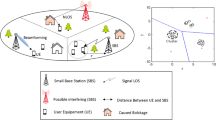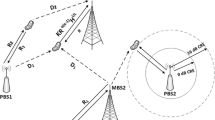Abstract
Low powered node densification leading to dense and ultra dense heterogeneous networks is a feature of 5th generation cellular networks. With this densification, the nature of the link between the transmitter and receiver in the network requires even more accurate and reliable models. For performance analysis of such networks where the rates of signal loss over distance becomes a significant parameter, more accurate path loss models should be used when analyzing user equipment (UE) association probability, coverage probability and average spectral efficiency. In this paper, we have considered a two-tier dense heterogeneous cellular network incorporating downlink uplink decoupled technique and have derived generalized expressions for UE association probability, decoupled uplink coverage probability and decoupled uplink average spectral efficiency using multi-slope path loss model. This path loss model broadly incorporates the effects of physical environment on the distance-dependent path loss. For simulation purpose, we have compared network performance while considering single-slope and dual-slope path loss models. The derived analytical expressions have been validated through network simulations and found in good agreement. Through comparison, it has been found that the decoupled UE association probability and uplink coverage probability is higher when incorporating multi-slope path loss model as compared to single-slope path loss model while the decoupled uplink spectral efficiency is observed to be lower when incorporating dual slope path loss model.










Similar content being viewed by others
References
Ericsson. (2018). Ericsson Mobility Report, Report June.
Cisco. (2018). Cisco Visual Networking Index: Forecast and Trends, 2017–2022.
Orlosky, J., Kiyokawa, K., & Takemura, H. (2017). Virtual and augmented reality on the 5G highway. Journal of Information Processing, 25, 133–141. https://doi.org/10.2197/ipsjjip.25.133.
Dhillon, H. S., Ganti, R. K., Baccelli, F., & Andrews, J. G. (2012). Modeling and analysis of K-tier downlink heterogeneous cellular networks. IEEE Journal on Selected Areas in Communications, 30, 550–560.
Novlan, T. D., Ganti, R. K., Ghosh, A., & Andrews, J. G. (2012). Analytical evaluation of fractional frequency reuse for heterogeneous cellular networks. IEEE Transactions on Communications, 60, 2029–2039.
Ghosh, A., Mangalvedhe, N., Ratasuk, R., Mondal, B., Cudak, M., Visotsky, E., et al. (2012). Heterogeneous cellular networks: From theory to practice. IEEE Communications Magazine, 50, 54–64.
Jo, H., Sang, Y. J., Xia, P., & Andrews, J. G. (2012). Heterogeneous cellular networks with flexible cell association: A comprehensive downlink SINR analysis. IEEE Transactions on Wireless Communications, 11, 3484–3495.
Ali, M. I. A. S., & Ahmed, I. (2016). Analysis of proportional fairness utility function and interference mitigation in heterogeneous cellular networks. In 31st IEEEP International multi-topic symposium, 17–18 March.
Zhang, Q., Yang, T., Zhang, Y., & Feng, Z. (2015). Fairness guaranteed novel eICIC technology for capacity enhancement in multi-tier heterogeneous cellular networks. EURASIP Journal on Wireless Communications and Networking, 2015, 1–12.
Andrews, J. G. (2013). Seven ways that HetNets are a cellular paradigm shift. IEEE Communications Magazine, 51(3), 136–144. https://doi.org/10.1109/MCOM.2013.6476878.
Elshaer, H., Boccardi, F., Dohler, M., & Irmer, R. (2014) Downlink and uplink decoupling: A disruptive architectural design for 5G networks. In 2014 IEEE Global communications conference, Austin, TX (pp. 1798–1803). https://doi.org/10.1109/GLOCOM.2014.7037069.
Boccardi, F., Andrews, J., Elshaer, H., Dohler, M., Parkvall, S., Popovski, P., et al. (2016). Why to decouple the uplink and downlink in cellular networks and how to do it. IEEE Communications Magazine Journal, 54(3), 110–117.
Singh, S., Zhang, X., & Andrews, J. G. (2015). Joint rate and SINR coverage analysis for decoupled uplink–downlink biased cell associations in HetNets. IEEE Transactions on Wireless Communications, 14(10), 5360–5373. https://doi.org/10.1109/TWC2015.2437378.
Arif, M., Wyne, S., Ahmed, J. (2019). Performance analysis of downlink and uplink decoupled access in clustered heterogeneous cellular networks. Telecommunication Systems. https://doi.org/10.1007/s11235-019-00571-x.
Shi, M., Yang, K., Xing, C., & Fan, R. (2018). Decoupled heterogeneous networks with millimeter wave small cells. IEEE Transactions on Wireless Communications, 17, 5871–5884.
Wu, J., Sun, K., Huang, W. (2018). Uplink performance improvement by frequency allocation and power control in heterogeneous networks. In 2018 24th Asia-Pacific conference on communications (APCC) (pp. 364–369).
Elshaer, H., Kulkarni, M. N., Boccardi, F., Andrews, J. G., & Dohler, M. (2016). Downlink and uplink cell association with traditional macrocells and millimeter wave small cells. IEEE Transactions on Wireless Communications, 15(9), 6244–6258. https://doi.org/10.1109/TWC.2016.2582152.
Bacha, M., Wu, Y., & Clerckx, B. (2017). Downlink and uplink decoupling in two-tier heterogeneous networks with multi-antenna base stations. IEEE Transactions on Wireless Communications, 16(5), 2760–2775. https://doi.org/10.1109/TWC.2017.2665466.
Smiljkovikj, K., Popovski, P., & Gavrilovska, L. (2015). Analysis of the decoupled access for downlink and uplink in wireless heterogeneous networks. IEEE Wireless Communications Letters Journal, 4(2), 173–176. https://doi.org/10.1109/LWC.2015.2388676.
Sattar, Z., Evangelista, J. V. C., Kaddoum, G., & Batani, N. (2019). Spectral efficiency analysis of the decoupled access for downlink and uplink in two-tier network. IEEE Transactions on Vehicular Technology, 68(5), 4871–4883.
Sial, M. N., & Ahmed, J. (2018). Analysis of K-tier 5G heterogeneous cellular network with dual-connectivity and uplink–downlink decoupled access. Journal of Telecommunication Systems, 67(4), 669–685. https://doi.org/10.1007/s11235-017-0368-2.
Sial, M. N., & Ahmed, J. (2018). A realistic uplink–downlink coupled and decoupled user association technique for K-tier 5G HetNets. Arabian Journal for Science and Engineering, 44, 2185–2204. https://doi.org/10.1007/s13369-018-3339-3.
Ahmed, J., & Sial, M. N. (2017). A novel and realistic hybrid downlink–uplink coupled/decoupled access scheme for 5G HetNets. Turkish Journal of Electrical Engineering and Computer Sciences, 25, 4457–4473. https://doi.org/10.3906/elk-1612-167.
Wang, H., Garcia-Lozano, M., Mutafungwa, E., Yin, X., & Ruiz, S. (2018). Performance study of uplink and downlink splitting in ultradense highly loaded networks. Wireless Communications and Mobile Computing, 2018, Article ID 1439512. https://doi.org/10.1155/2018/1439512.
Xia, H. H. (1997). A simplified analytical model for predicting path loss in urban and suburban environments. IEEE Transactions on Vehicular Technology, 46(4), 1040–1046. https://doi.org/10.1109/25.653077.
Erceg, V., Greenstein, L. J., Tjandra, S. Y., Parkoff, S. R., Gupta, A., Kulic, B., et al. (1999). An empirically based path loss model for wireless channels in suburban environments. IEEE Journal on Selected Areas in Communications, 17(7), 1205–1211. https://doi.org/10.1109/49.778178.
Sarkar, T. K., Zhong, J., Kyungjung, K., Medouri, A., & Salazar-Palma, M. (2003). A survey of various propagation models for mobile communication. IEEE Antennas and Propagation Magazine, 45(3), 51–82. https://doi.org/10.1109/MAP.2003.1232163.
Xia, H., Bertoni, H. L., Maciel, L. R., Lindsay-Stewart, A., & Rowe, R. (1993). Radio propagation characteristics for line-of-sight microcellular and personal communications. IEEE Transactions on Antennas and Propagation, 41(10), 1439–1447. https://doi.org/10.1109/8.247785.
Rappaport, T. S., & Milstein, L. B. (1992). Effects of radio propagation path loss on DS-CDMA cellular frequency reuse efficiency for the reverse channel. IEEE Transactions on Vehicular Technology, 41(3), 231–242. https://doi.org/10.1109/25.155970.
Erceg, V., Ghassemzadeh, S., Taylor, M., Li, D., & Schilling, D. L. (1992). Urban/suburban out-of-sight propagation modeling. IEEE Communications Magazine, 30(6), 56–61. https://doi.org/10.1109/35.141584.
Feuerstein, M. J., Blackard, K. L., Rappaport, T. S., Seidel, S. Y., & Xia, H. H. (1994). Path loss, delay spread, and outage models as functions of antenna height for microcellular system design. IEEE Transactions on Vehicular Technology, 43(3), 487–498. https://doi.org/10.1109/25.312809.
Zhang, X., & Andrews, J. G. (2015). Downlink cellular network analysis with multi-slope path loss models. Journal of IEEE Transactions on Communications, 63(5), 1881–1894. https://doi.org/10.1109/TCOMM.2015.2413412.
Liu, J., Xiao, W., & Soong, A. (2015). Dense networks of small cells. In A. Anpalagan, M. Bennis, & R. Vannithamby (Eds.), Design and deployment of small cell networks (pp. 96–121). Cambridge: Cambridge University Press. https://doi.org/10.1017/CBO9781107297333.006.
Meinilä, J., Kyösti, P., Jämsä, T., & Hentilä, L. (2009). WINNER II Channel models. In M. Döttling, W. Mohr & A. Osseiran (Eds.), Radio technologies and concepts for IMT-advanced. https://doi.org/10.1002/9780470748077.ch3.
3GPP. (2010). Further advancements for E-UTRA physical layer aspects (release 9), 3GPP TR36.814 V9.0.0, March.
Gupta, A. K., Zhang, X., & Andrews, J. G. (2015). SINR and throughput scaling in ultradense urban cellular networks. IEEE Wireless Communications Letters, 4(6), 605–608. https://doi.org/10.1109/LWC.2015.2472404.
Nguyen, V. M., & Kountouris, M. (2016). Coverage and capacity scaling laws in downlink ultra-dense cellular networks. In 2016 IEEE International conference on communications (ICC) (pp. 1–7).
Ammouri, A. A., Andrews, J. G., & Baccelli, F. (2018). A unified asymptotic analysis of area spectral efficiency in ultradense cellular networks. IEEE Transactions on Information Theory, 65(2), 1236–1248. https://doi.org/10.1109/TIT.2018.2845380.
Yang, B., Mao, G., Ding, M., Ge, X., & Tao, X. (2018). Dense small cell networks: From noise-limited to dense interference-limited. IEEE Transactions on Vehicular Technology, 67(5), 4262–4277. https://doi.org/10.1109/TVT.2018.2794452.
Munir, H., Hassan, S. A., Pervaiz, H., Ni, Q., & Musavian, L. (2017). Resource Optimization in multi-tier HetNets exploiting multi-slope path loss model. IEEE Access, 5, 8714–8726. https://doi.org/10.1109/ACCESS.2017.2699941.
Munir, H., Hassan, S. A., Pervaiz, H., Ni, Q., & Musavian, L. (2017). User association in 5G heterogeneous networks exploiting multi-slope path loss model. In 2017 2nd Workshop on recent trends in telecommunications research (RTTR) (pp. 1–5).
Author information
Authors and Affiliations
Corresponding author
Additional information
Publisher's Note
Springer Nature remains neutral with regard to jurisdictional claims in published maps and institutional affiliations.
Appendix A
Appendix A
From (19) in Sect. 4.1, \({I_{{x_S}}}\) is defined as the total uplink interference experienced by the tagged SBS. In order to find \({f_{{x_S}}}({x_S})\), we first consider the CCDF of \({f_{{x_S}}}({x_S})\) defined in (38). Incorporating distance distributions in (38) results in (39). Solving (39), we get (40) which is the PDF of distance distribution obtained by derivating the \(CDF=1-CCDF\) of \({f_{{x_S}}}({x_S})\) with respect to x.
For (19), as \({h_{{x_S}}} \sim \exp (1)\), averaging over \({h_{{x_S}}}\) will give us:
where \({{{\mathcal {L}}}_{{I_{{x_S}}}}}(s)\) is the Laplacian and \(s = \tau P_d^{ - 1}\prod \nolimits _{j = 1}^{{n_S}} {R_j^{{\alpha _{j - 1}} - {\alpha _j}}} {\left\| {{x_S}} \right\| ^{{\alpha _{{n_S}}}}}\). The uplink interference in (41) caused by the Interferer UEs to the serving SBS (uplink) is defined as:
where \({Z_i}\) represent distance between the tagged small BS (serving the test UE) and the Interferer UE. The Laplace functional in (41) can be written as:
As \({h_i} \sim \exp (1)\), (43) can be written as:
Since \(E\left[ {\prod {f(X)} } \right] = {e^{\left( { - \lambda \int \limits _{{R^d}} {(1 - f(X))dX} } \right) }}\) , (44) can be reduced to:
where \({\lambda _{{I_d}}} = \left( {{\lambda _M} + {\lambda _S}} \right) (1 - {e^{ - \pi \left( {{\lambda _M} + {\lambda _S}} \right) {z^2}}})\) is the effective interference field (an approximate model) as observed from the Serving BS, which is a non-homogeneous PPP \(\phi _{{I_d}}\). Putting \({\lambda _{{I_d}}}\) in (45), we get:
Rights and permissions
About this article
Cite this article
Ali, S., Aslam, M.I. & Ahmed, I. Uplink coverage probability and spectral efficiency for downlink uplink decoupled dense heterogeneous cellular network using multi-slope path loss model. Telecommun Syst 72, 505–516 (2019). https://doi.org/10.1007/s11235-019-00587-3
Published:
Issue Date:
DOI: https://doi.org/10.1007/s11235-019-00587-3




